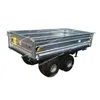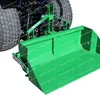Agricultural implements are essential tools and machinery used in farming to enhance efficiency, productivity, and sustainability. These implements range from simple hand tools to advanced mechanized equipment, designed to perform various tasks such as soil preparation, planting, cultivation, harvesting, and post-harvest processing. With the evolution of technology, modern agricultural implements have become more sophisticated, incorporating features like GPS guidance, automated controls, and energy-efficient operations. This article provides a comprehensive overview of key agricultural implements, their specifications, and answers to frequently asked questions, helping farmers and agribusiness professionals make informed decisions.
Agricultural implements can be categorized based on their function and application. Common types include tillage equipment, planting machinery, irrigation systems, harvesting tools, and implements for crop maintenance. Each type serves a specific purpose in the agricultural cycle, contributing to overall farm management.
Understanding the technical specifications of agricultural implements is crucial for selecting the right equipment. Below, we detail parameters for some popular implements using lists and tables for clarity.
| Parameter | Specification | Unit |
|---|---|---|
| Model | MP-2023 | - |
| Number of Bottoms | 3-5 | pieces |
| Operating Speed | 5-8 | km/h |
| Lift Type | Hydraulic | - |
| Warranty | 2 years | - |
| Parameter | Specification | Unit |
|---|---|---|
| Model | SD-3050 | - |
| Number of Rows | 12-24 | rows |
| Seed Placement Accuracy | ±1 cm | - |
| Drive System | Mechanical or hydraulic | - |
| Warranty | 3 years | - |
| Parameter | Specification | Unit |
|---|---|---|
| Model | CH-5000 | - |
| Harvesting Capacity | 2-5 hectares/hour | ha/h |
| Threshing System | Axial-flow | - |
| Operator Cabin | Air-conditioned, soundproof | - |
| Warranty | 2 years or 2000 hours | - |
What are the main types of agricultural implements used in modern farming?
Modern farming utilizes a wide range of implements, including plows, harrows, seed drills, planters, sprayers, irrigators, combine harvesters, and balers. These are designed for tasks like soil preparation, planting, crop protection, irrigation, harvesting, and baling, often integrated with technology for precision agriculture.
How do I choose the right agricultural implement for my farm?
Selecting the right implement depends on factors such as farm size, soil type, crop variety, climate conditions, available tractor power, and budget. Consult specifications like working width, depth capacity, material durability, and compatibility with existing equipment. It's advisable to test implements or seek expert recommendations based on local farming practices.
What maintenance is required for agricultural implements to ensure longevity?
Regular maintenance includes cleaning after use to remove debris, lubricating moving parts, inspecting for wear and damage, sharpening or replacing blades, checking hydraulic systems for leaks, and storing implements in a dry, covered area. Follow the manufacturer's guidelines for scheduled servicing to prevent breakdowns and extend lifespan.
Are there eco-friendly options available in agricultural implements?
Yes, many modern implements are designed for sustainability, featuring energy-efficient operations, reduced soil disturbance (e.g., no-till drills), precision application of inputs to minimize waste, and compatibility with renewable energy sources. Look for implements with certifications for environmental standards.
How has technology improved agricultural implements in recent years?
Technological advancements have led to smart implements with GPS guidance for accuracy, sensors for real-time data collection, automation for reduced labor, IoT connectivity for remote monitoring, and software integration for data analysis. These improvements enhance productivity, reduce costs, and support sustainable farming practices.
What safety precautions should be taken when using agricultural implements?
Always read the operator's manual before use, wear appropriate protective gear (e.g., gloves, goggles), ensure implements are properly hitched to tractors, keep bystanders away during operation, avoid wearing loose clothing, and regularly check for safety features like guards and emergency stops. Training on safe operation is essential for all users.
Can agricultural implements be used for organic farming?
Absolutely. Many implements are suitable for organic farming, such as cultivators for weed control without chemicals, organic seeders, and harvesters designed to handle organic crops. Ensure implements are cleaned thoroughly if switching from conventional to organic use to avoid contamination.
What is the average lifespan of agricultural implements?
Lifespan varies based on type, usage frequency, maintenance, and material quality. Simple hand tools may last 5-10 years, while mechanized implements like tractors or combines can last 10-20 years with proper care. Regular upkeep and part replacements can significantly extend longevity.
How do I troubleshoot common issues with agricultural implements?
Common issues include clogging, uneven performance, or mechanical failures. Start by checking for obstructions, ensuring proper calibration, inspecting for worn parts, and referring to the troubleshooting section of the manual. For complex problems, contact a certified technician or the manufacturer's support service.
Are there financing or rental options for agricultural implements?
Yes, many dealers and agricultural suppliers offer financing plans, leases, or rental services to make implements more accessible. This allows farmers to use advanced equipment without large upfront investments, especially for seasonal needs. Explore local programs or online platforms for options.





